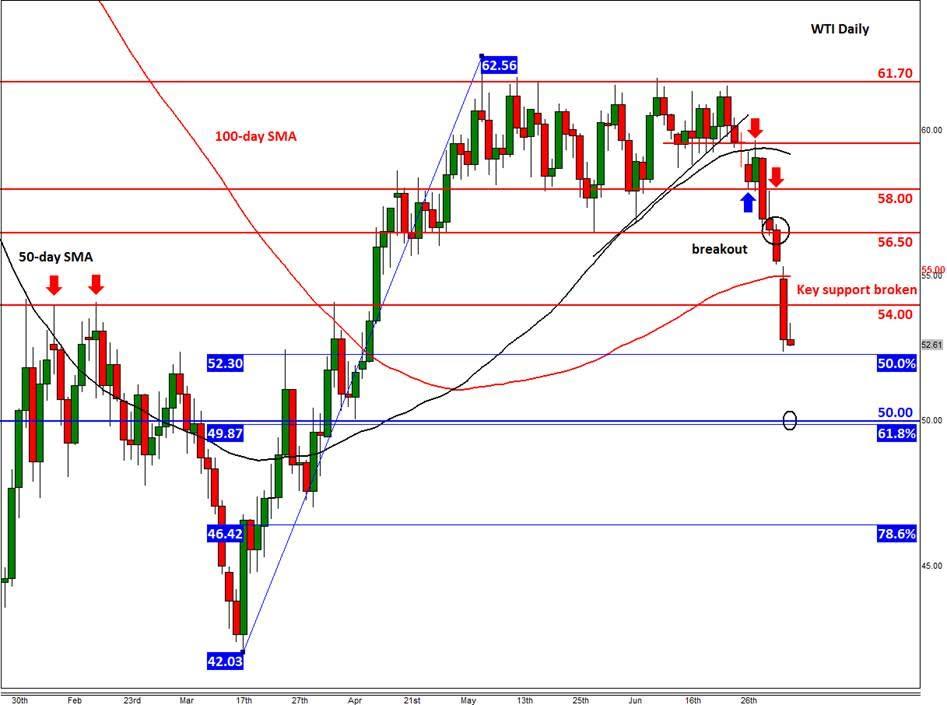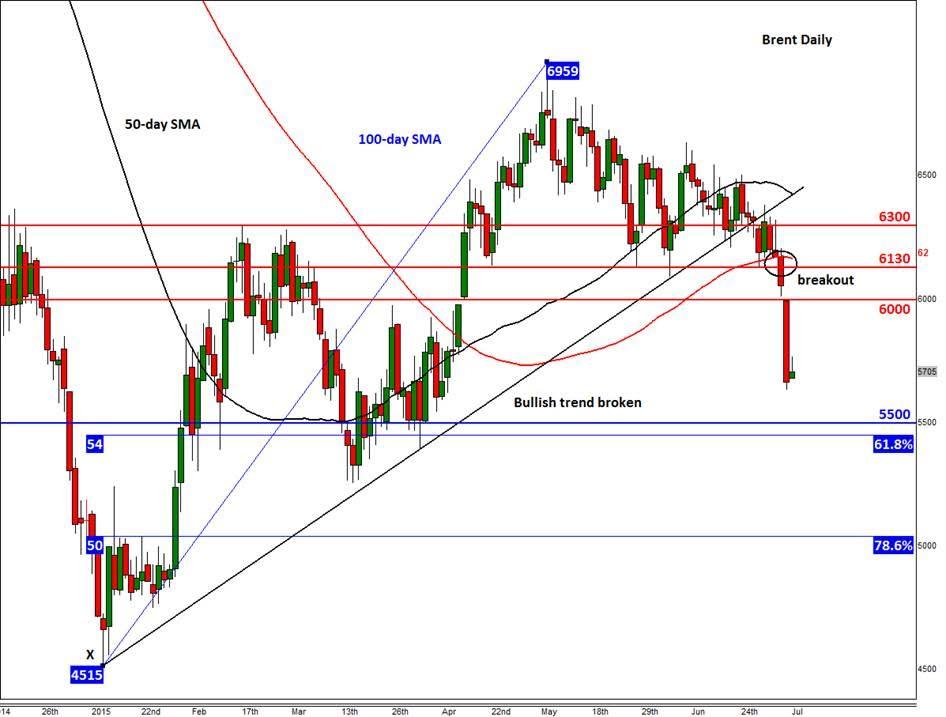![]()
As we reported the possibility at the end of last week, oil prices have absolutely plunged in recent days. On Monday alone, Brent dropped by more than 6% while WTI shed almost 8%. The vicious sell-off has been driven by a number of factors, not least the technical breakdown that resulted at the end of last week when Brent took out key support at $61.30 and WTI $56.50. The sell-off in WTI has been more pounced. That’s because the destocking in US crude oil inventories ended after eight weeks and the rig count increased for the first time in several months, both raising concerns that the supply surplus is here to stay for the long run.
But the main reason why prices have fallen this dramatically in my view is because of optimism that a nuclear deal with Iran will be reached soon which would allowed it to eventually add up to 1 million barrels of oil per day in the already-saturated market. That would be significant, make no mistake about it. One has to wonder how this potential increase in supply will be accommodated for as after all the other OPEC members are in no mood to lose further market share, not only to Iran but also to US shale producers. The latest news regarding Iran is that the talks are still on-going, but the self-imposed deadline will be extended again by "couple of days", according to the European Union foreign policy chief Federica Mogherini. If sanctions are eventually lifted, Iran will probably not care much about the recent falls in oil prices; they will try to sell as much of the stuff as possible like all the other OPEC members for if they don’t they will lose out.
On the demand side, so much attention has been wrongly attributed to Greece. The fact of the matter is that besides Greece being a beautiful country, it is a small nation who will continue to use oil whether in or out of the Eurozone. The elephant in the room is actually China. Oil speculators are spooked by the weakening of macroeconomic data in the world’s second largest oil consumer nation. The recent stock market turmoil there underscores this view. If demand from China were to fall at the time the world oil supply is increasing then it could only mean one thing: downward adjustment in prices.
As mentioned, both contracts have been hammered after the technical breakdown that resulted at the end of last week. That breakdown probably caused oil bulls, worried about another leg lower in prices, to rush for the exits. Up until a few weeks ago, net long positions from hedge funds and other money managers in Brent had reached a record level and they were extremely high in WTI too, according to data from the ICE and CFTC. As this group of market participants have been proven wrong, they are likely to have covered those positions en masse. At the same time, oil bears, smelling blood, have absolutely mauled the bulls. They have been encouraged to come into play after the recent consolidation ended with price breaking lower.
The important question is where do we go from here? Although admittedly the sell-off is beginning to look a little bit over-done in the near-term, that’s not to say prices cannot fall further over time. Such sharp price moves typically reach at least their 61.8% Fibonacci levels. But given that the rally from March failed to even achieve a relatively-shallow 38.2% retracement in the downtrend from last year’s slump, I wouldn’t be surprised if prices fell back to their March lows or indeed even break below them. Still, the importance of the 61.8% Fibonacci levels should be underestimated, especially as in the case of WTI it is at around the psychologically-important $50 handle. On Brent, the corresponding Fibonacci level is around $54.50, which is just below the psychological $55 handle. Around these levels we may see some profit-taking, which could provide some short-term support for prices. The broken supports could now turn into resistance upon re-test.


Recommended Content
Editors’ Picks
EUR/USD edges lower toward 1.0700 post-US PCE

EUR/USD stays under modest bearish pressure but manages to hold above 1.0700 in the American session on Friday. The US Dollar (USD) gathers strength against its rivals after the stronger-than-forecast PCE inflation data, not allowing the pair to gain traction.
GBP/USD retreats to 1.2500 on renewed USD strength

GBP/USD lost its traction and turned negative on the day near 1.2500. Following the stronger-than-expected PCE inflation readings from the US, the USD stays resilient and makes it difficult for the pair to gather recovery momentum.
Gold struggles to hold above $2,350 following US inflation

Gold turned south and declined toward $2,340, erasing a large portion of its daily gains, as the USD benefited from PCE inflation data. The benchmark 10-year US yield, however, stays in negative territory and helps XAU/USD limit its losses.
Bitcoin Weekly Forecast: BTC’s next breakout could propel it to $80,000 Premium

Bitcoin’s recent price consolidation could be nearing its end as technical indicators and on-chain metrics suggest a potential upward breakout. However, this move would not be straightforward and could punish impatient investors.
Week ahead – Hawkish risk as Fed and NFP on tap, Eurozone data eyed too

Fed meets on Wednesday as US inflation stays elevated. Will Friday’s jobs report bring relief or more angst for the markets? Eurozone flash GDP and CPI numbers in focus for the Euro.